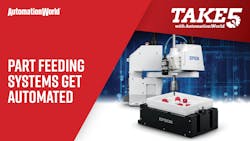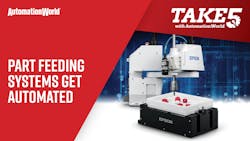Quick hits:
- Learn why robots, vision, and artificial intelligence are being added to vibratory feeder technology.
- Find out how a system integrator combined multiple automation technologies from Omron to create a specific automated parts feeding system.
- Get insights into Epson Robots IntelliFlex system which uses artificial intelligence to quickly adapt to new parts.
Related to this episode:
- Omron Automation's rise of flexible feeding system technology
- All-in-one flexible feeder systems from Epson Robots
- Download PMMI's Cybersecurity White Paper to learn the most important actions you can take now to avoid a costly cyber attack.
I'm David Greenfield, Director of Content at Automation World, and thanks for joining me for this Take Five episode, where I'll be highlighting how the application of robotics, vision systems, and artificial intelligence are changing part feeder technology. Feeding systems are a commonly used automation technology that sort parts in a particular direction for handling by another automated system or humans for assembly and packaging. And these feeders use vibration and gravity to move components, so they're fairly simple systems that have proven to work safely and effectively in a variety of applications ranging from pharmaceutical, automotive, and electronics to cosmetics and food. But as effective as this technology is, there are some downsides to it, namely that whenever a part is changed, the bowl feeder also needs to be changed to a design for the new part. And this, of course, increases changeover time.
And because of this lack of flexibility in bowl feeder design, a new trend in parts feeding is emerging that involves the integration of multiple automation technologies to create a flexible feeding system capable of doing what a vibratory bowl feeder does, but for many different part types. For example, Armo Tool, which is a Canada based supplier of industrial tooling and automation, they combined Omron Automation's AnyFeeder Part Feeding System with rotary and linear servos as well as Omron's FH Vision Systems, eCobra SCARA robots, and a Sysmac controller to develop a flexible feeding system for an automotive supplier company. Now, this company had used basic vibratory bowl feeders to sort informed fittings that attached to brake lines, and with the new system, the automotive supplier increased its part handling efficiency to 99% from the 70% efficiencies it was able to achieve with a basic vibratory bowl feeder.
Now, this efficiency increase has been a really big boost to the end user because it ensures that the right part is selected pretty much every time, which is a big deal for a plant that manufactures brake lines for multiple vehicle models.
Another example of the advances being made to part feeder systems can be seen in Epson Robots' IntelliFlex's flexible feeder system. Now, a key aspect of Epson Robots' approach to flexible feeding system is it's all in one system delivery that includes separate feeder communication protocols, feeder tuning requirements, vision system calibration and programming, and system programming and optimization to coordinate the robot, feeder, and vision system components of the system. Now, Epson Robots' approach is to combine all of these components into one system that integrates vision programming, part tuning, and parts control adjustment.
Now, according to Epson, this integration allows for the IntelliFlex system to be set up and running in one day rather than the weeks it can take to set up a flexible feeder system. And the IntelliFlex system can handle a variety of part sizes and types through its use of Epson's RC Plus integrated software environment, which is used to program and control all aspects of the flexible feeder system. The software feature's built in command sets for parts feeding so that engineers don't have to figure this out for themselves and the user interface provides a point and click way to program the feeder. In addition, the RC Plus' software, their use of artificial intelligence, enables auto tuning of the IntelliFlex system. This means that if you set up the system for one part and then need to move to the next part for a different product setting up for the new part in the system can be done with the software's built built-in wizards for training the algorithm.
Now, Epson Robots says the AI can be trained just by dropping 10 parts on the feeder and then the software uses the built-in algorithm to determine the right set of vibrations or frequency to spread those parts out for optimized feeding. Now, Epson says there's no trial and error with this process. You just let the machine do the automated tuning calibration for you. And according to the company, the longest it takes a system to self adjust to new parts is about five minutes, but the process typically takes only about two minutes.
So I hope you enjoyed this Take Five with Automation World, and remember to keep watching this space for new episodes each week to help keep you on top of what's happening in the world of industrial automation.
Leaders relevant to this content:






